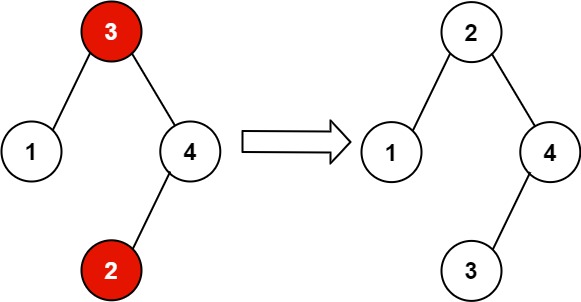LeetCode - Medium - 99. Recover Binary Search Tree
Topic
- Tree
- Depth-first Search
Description
https://leetcode.com/problems/recover-binary-search-tree/
You are given the root of a binary search tree (BST), where exactly two nodes of the tree were swapped by mistake. Recover the tree without changing its structure.
Follow up: A solution using O(n) space is pretty straight forward. Could you devise a constant space solution?
Example 1:
Input: root = [1,3,null,null,2]Output: [3,1,null,null,2]Explanation: 3 cannot be a left child of 1 because 3 > 1. Swapping 1 and 3 makes the BST valid.
Example 2:
Input: root = [3,1,4,null,null,2]Output: [2,1,4,null,null,3]Explanation: 2 cannot be in the right subtree of 3 because 2 < 3. Swapping 2 and 3 makes the BST valid.
Constraints:
- The number of nodes in the tree is in the range
[2, 1000]. - − 2 31 < = N o d e . v a l < = 2 31 − 1 -2^{31} <= Node.val <= 2^{31} - 1 −231<=Node.val<=231−1
Analysis
方法一:用到中序遍历模式迭代版,找出相邻前后位置异常两个节点,放入candidates,这种节点最少有2个,最多有4个。然后,在candidates中找出最小值节点和最大值节点。最后,这两最值节点交换值。
方法二:方法一的改进,不用candidates,迭代找出相邻前后位置异常两个节点,取前者为first,后者为second。然后迭代再找出相邻前后位置异常两个节点,然后取小者为second。(这步可能没用到,试想,已排序的数列中,仅相邻一对数交换位置)。最后,first、second互换节点值。
方法三:Morris Traversal。时杂度O(N),空杂度O(1),没用到栈。
Submission
import java.util.ArrayList;import java.util.LinkedList;import java.util.List;import com.lun.util.BinaryTree.TreeNode;public class RecoverBinarySearchTree {//方法一:我写的,用到中序遍历模式public void recoverTree(TreeNode root) {TreeNode p = root;LinkedList<TreeNode> stack = new LinkedList<>();List<TreeNode> candidates = new ArrayList<>();TreeNode prev = null;while(!stack.isEmpty() || p != null) {if(p != null) {stack.push(p);p = p.left;}else {TreeNode node = stack.pop();if(prev != null && prev.val >= node.val) {candidates.add(prev);candidates.add(node);if(candidates.size() == 4) break;}prev = node;p = node.right;}}TreeNode min = candidates.get(0), max = min;for(TreeNode node : candidates) {if(node.val < min.val)min = node;if(node.val > max.val)max = node;}int temp = min.val;min.val = max.val;max.val = temp;}//方法二:方法一的改进public void recoverTree2(TreeNode root) {LinkedList<TreeNode> stack = new LinkedList<>();TreeNode first = null, second = null;TreeNode prev = null, curr = root;while(!stack.isEmpty() || curr != null) {if(curr != null) {stack.push(curr);curr = curr.left;}else {curr = stack.pop();if(prev != null && prev.val >= curr.val) {//incorrect smaller node is always found as prev nodeif(first == null)first = prev;//incorrect larger node is always found as curr nodesecond = curr;}prev = curr;curr = curr.right;}}int temp = first.val;first.val = second.val;second.val = temp;}// 方法三:Morris遍历算法public void recoverTree3(TreeNode root) {TreeNode pre = null;TreeNode first = null, second = null;// Morris TraversalTreeNode temp = null;while (root != null) {if (root.left != null) {// connect threading for roottemp = root.left;while (temp.right != null && temp.right != root)temp = temp.right;// the threading already existsif (temp.right != null) {if (pre != null && pre.val > root.val) {if (first == null) {first = pre;}second = root;}pre = root;temp.right = null;root = root.right;} else {// construct the threadingtemp.right = root;root = root.left;}} else {if (pre != null && pre.val > root.val) {if (first == null) {first = pre;}second = root;}pre = root;root = root.right;}}// swap two node values;if (first != null && second != null) {int t = first.val;first.val = second.val;second.val = t;}}}
Test
import static org.junit.Assert.*;import org.junit.Test;import com.lun.util.BinaryTree;import com.lun.util.BinaryTree.TreeNode;public class RecoverBinarySearchTreeTest {@Testpublic void test() {RecoverBinarySearchTree obj = new RecoverBinarySearchTree();TreeNode root1 = BinaryTree.integers2BinaryTree(1,3,null,null,2);TreeNode expected1 = BinaryTree.integers2BinaryTree(3,1,null,null,2);obj.recoverTree(root1);assertTrue(BinaryTree.equals(root1, expected1));//---TreeNode root2 = BinaryTree.integers2BinaryTree(3,1,4,null,null,2);TreeNode expected2 = BinaryTree.integers2BinaryTree(2,1,4,null,null,3);obj.recoverTree(root2);assertTrue(BinaryTree.equals(root2, expected2));//---TreeNode root3 = BinaryTree.integers2BinaryTree(3, 9, 6, null, null, 5, 8, null, null, 7, 2);TreeNode expected3 = BinaryTree.integers2BinaryTree(3, 2, 6, null, null, 5, 8, null, null, 7, 9);obj.recoverTree(root3);assertTrue(BinaryTree.equals(root3, expected3));}@Testpublic void test2() {RecoverBinarySearchTree obj = new RecoverBinarySearchTree();TreeNode root1 = BinaryTree.integers2BinaryTree(1,3,null,null,2);TreeNode expected1 = BinaryTree.integers2BinaryTree(3,1,null,null,2);obj.recoverTree2(root1);assertTrue(BinaryTree.equals(root1, expected1));//---TreeNode root2 = BinaryTree.integers2BinaryTree(3,1,4,null,null,2);TreeNode expected2 = BinaryTree.integers2BinaryTree(2,1,4,null,null,3);obj.recoverTree2(root2);assertTrue(BinaryTree.equals(root2, expected2));//---TreeNode root3 = BinaryTree.integers2BinaryTree(3, 9, 6, null, null, 5, 8, null, null, 7, 2);TreeNode expected3 = BinaryTree.integers2BinaryTree(3, 2, 6, null, null, 5, 8, null, null, 7, 9);obj.recoverTree2(root3);assertTrue(BinaryTree.equals(root3, expected3));}@Testpublic void test3() {RecoverBinarySearchTree obj = new RecoverBinarySearchTree();TreeNode root1 = BinaryTree.integers2BinaryTree(1,3,null,null,2);TreeNode expected1 = BinaryTree.integers2BinaryTree(3,1,null,null,2);obj.recoverTree3(root1);assertTrue(BinaryTree.equals(root1, expected1));//---TreeNode root2 = BinaryTree.integers2BinaryTree(3,1,4,null,null,2);TreeNode expected2 = BinaryTree.integers2BinaryTree(2,1,4,null,null,3);obj.recoverTree3(root2);assertTrue(BinaryTree.equals(root2, expected2));//---TreeNode root3 = BinaryTree.integers2BinaryTree(3, 9, 6, null, null, 5, 8, null, null, 7, 2);TreeNode expected3 = BinaryTree.integers2BinaryTree(3, 2, 6, null, null, 5, 8, null, null, 7, 9);obj.recoverTree3(root3);assertTrue(BinaryTree.equals(root3, expected3));}}



































还没有评论,来说两句吧...